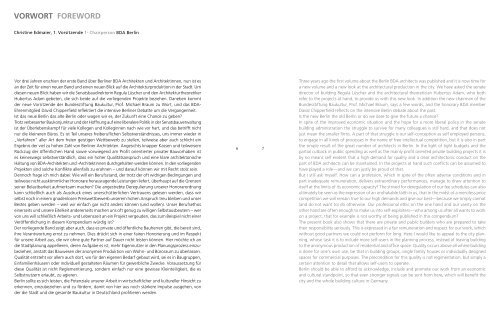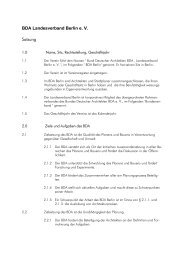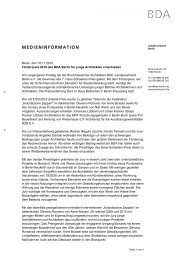Download PDF - BDA Berlin
Download PDF - BDA Berlin
Download PDF - BDA Berlin
Erfolgreiche ePaper selbst erstellen
Machen Sie aus Ihren PDF Publikationen ein blätterbares Flipbook mit unserer einzigartigen Google optimierten e-Paper Software.
Vorwort Foreword<br />
Christine Edmaier, 1. Vorsitzende 1 st Chairperson <strong>BDA</strong> <strong>Berlin</strong><br />
Vor drei Jahren erschien der erste Band über <strong>Berlin</strong>er <strong>BDA</strong> Architekten und Architektinnen, nun ist es<br />
an der Zeit für einen neuen Band und einen neuen Blick auf die Architekturproduktion in der Stadt. Um<br />
diesen neuen Blick haben wir die Senatsbaudirektorin Regula Lüscher und den Architekturtheoretiker<br />
Hubertus Adam gebeten, die sich beide auf die vorliegenden Projekte beziehen. Daneben kommt<br />
der neue Vorsitzende der Bundesstiftung Baukultur, Prof. Michael Braum zu Wort, und das <strong>BDA</strong>-<br />
Ehrenmitglied David Chipperfield reflektiert die intensive <strong>Berlin</strong>er Debatte um die Vergangenheit.<br />
Ist das neue <strong>Berlin</strong> das alte <strong>Berlin</strong> oder wagen wir es, der Zukunft eine Chance zu geben?<br />
Trotz verbesserter Baukonjunktur und der Hoffnung auf eine liberalere Politik in der Senatsbauverwaltung<br />
ist der Überlebenskampf für viele Kollegen und Kolleginnen nach wie vor hart, und das betrifft nicht<br />
nur die kleineren Büros. Es ist Teil unseres freiberuflichen Selbstverständnisses, uns immer wieder in<br />
„Verfahren“ aller Art dem freien geistigen Wettbewerb zu stellen, teilweise aber auch schlicht ein<br />
Ergebnis der viel zu hohen Zahl von <strong>Berlin</strong>er Architekten. Angesichts knapper Kassen und teilweisem<br />
Rückzug der öffentlichen Hand sowie vorwiegend am Profit orientierter privater Bauvorhaben ist<br />
es keineswegs selbstverständlich, dass ein hoher Qualitätsanspruch und eine klare architektonische<br />
Haltung von <strong>BDA</strong>-Architekten und -Architektinnen durchgehalten werden können. In den vorliegenden<br />
Projekten sind solche Konflikte allenfalls zu erahnen – und darauf können wir mit Recht stolz sein.<br />
Dennoch frage ich mich dabei: Wie will ein Berufsstand, der trotz der oft widrigen Bedingungen und<br />
teilweise nicht auskömmlicher Honorare herausragende Leistungen liefert, überhaupt auf die Grenzen<br />
seiner Belastbarkeit aufmerksam machen? Die angestrebte Deregulierung unserer Honorarordnung<br />
kann schließlich auch als Ausdruck eines unerschütterlichen Vertrauens gelesen werden, dass wir<br />
selbst noch in einem gnadenlosen Preiswettbewerb unserem hohen Anspruch treu bleiben und unser<br />
Bestes geben werden – weil wir einfach gar nicht anders können (und wollen). Unser Berufsethos<br />
einerseits und unsere Eitelkeit andererseits machen uns oft genug zu willigen Selbstausbeutern – wer<br />
von uns will schließlich Arbeits- und Lebenszeit an ein Projekt vergeuden, das zum Beispiel nicht einer<br />
Veröffentlichung in diesem Kompendium würdig ist?<br />
Der vorliegende Band zeigt aber auch, dass es private und öffentliche Bauherren gibt, die bereit sind,<br />
ihre Verantwortung ernst zu nehmen. Dies drückt sich in einer fairen Honorierung und im Respekt<br />
für unsere Arbeit aus, die wir ohne gute Partner auf Dauer nicht leisten können. Hier möchte ich an<br />
die Stadtplanung appellieren, deren Aufgabe es ist, mehr Eigennutzer in den Planungsprozess einzubeziehen,<br />
anstatt das Bauwesen der anonymen Produktion von Wohn- und Büroraum zu überlassen.<br />
Qualität entsteht vor allem auch dort, wo für den eigenen Bedarf gebaut wird, sei es in Baugruppen,<br />
Einfamilienhäusern oder individuell gestalteten Räumen für gewerbliche Zwecke. Voraussetzung für<br />
diese Qualität ist nicht Reglementierung, sondern einfach nur eine gewisse Kleinteiligkeit, die es<br />
Selbstnutzern erlaubt, zu agieren.<br />
<strong>Berlin</strong> sollte es sich leisten, die Potenziale unserer Arbeit in wirtschaftlicher und kultureller Hinsicht zu<br />
erkennen, einzubeziehen und zu fördern, damit von hier aus noch stärkere Impulse ausgehen, von<br />
der die Stadt und die gesamte Baukultur in Deutschland profitieren werden.<br />
6<br />
7<br />
Three years ago the first volume about the <strong>Berlin</strong> <strong>BDA</strong> architects was published and it is now time for<br />
a new volume and a new look at the architectural production in the city. We have asked the senate<br />
director of building Regula Lüscher and the architectural theoretician Hubertus Adam, who both<br />
refer to the projects at hand, to provide us with this new look. In addition the new chairman of the<br />
Bundesstiftung Baukultur, Prof. Michael Braum, says a few words, and the honorary <strong>BDA</strong> member<br />
David Chipperfield reflects on the intensive <strong>Berlin</strong> debate about the past.<br />
Is the new <strong>Berlin</strong> the old <strong>Berlin</strong> or do we dare to give the future a chance?<br />
In spite of the improved economic situation and the hope for a more liberal policy in the senate<br />
building administration the struggle to survive for many colleagues is still hard, and that does not<br />
just mean the smaller firms. A part of that struggle is our self-conception as self employed persons,<br />
to engage in all kinds of processes in the name of free intellectual competition, but it is also in part<br />
the simple result of the great number of architects in <strong>Berlin</strong>. In the light of tight budgets and the<br />
partial cutback in public spending as well as the mainly profit oriented private building projects it is<br />
by no means self evident that a high demand for quality and a clear architectonic conduct on the<br />
part of <strong>BDA</strong> architects can be maintained. In the projects at hand such conflicts can be assumed to<br />
have played a role—and we can justly be proud of that.<br />
But I still ask myself: How can a profession, which in spite of the often adverse conditions and in<br />
part inadequate remuneration, delivers extraordinary performances, manage to draw attention to<br />
itself at the limits of its economic capacity? The strived for deregulation of our fee schedules can also<br />
ultimately be seen as the expression of an unshakable faith in us, that in the midst of a merciless price<br />
competition we will remain true to our high demands and give our best—because we simply cannot<br />
(and do not want to) do otherwise. Our professional ethic on the one hand and our vanity on the<br />
other hand are often enough to make us into self-exploiters—who among us after all wants to work<br />
on a project, that for example is not worthy of being published in this compendium?<br />
The present book also shows that there are private and public builders who are prepared to take<br />
their responsibility seriously. This is expressed in a fair remuneration and respect for our work, which<br />
without good partners we could not perform for long. Here I would like to appeal to the city planning,<br />
whose task it is to include more self-users in the planning process, instead of leaving building<br />
to the anonymous production of residential and office space. Quality occurs above all where building<br />
is done for one’s own use, be that in building groups, single family houses or individually designed<br />
spaces for commercial purposes. The precondition for this quality is not regimentation, but simply a<br />
certain attention to detail that allows self-users to operate.<br />
<strong>Berlin</strong> should be able to afford to acknowledge, include and promote our work from an economic<br />
and cultural standpoint, so that even stronger signals can be sent from here, which will benefit the<br />
city and the whole building culture in Germany.







